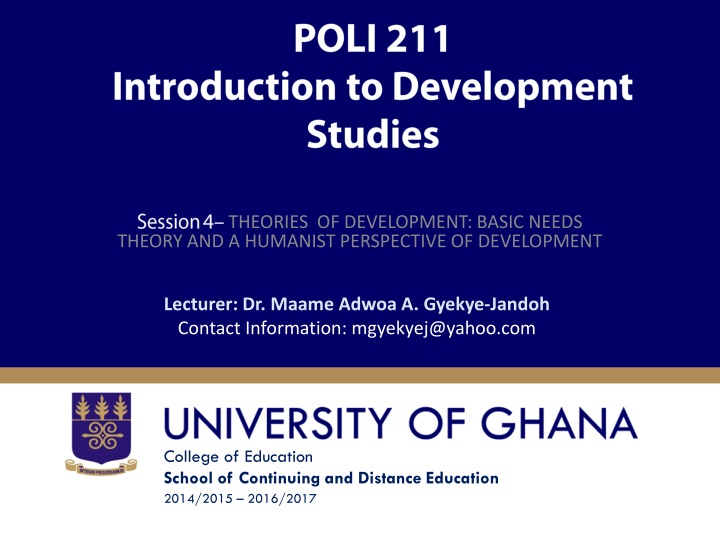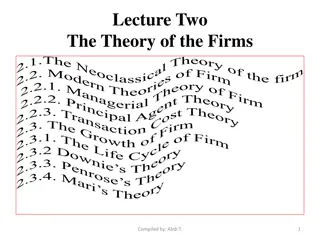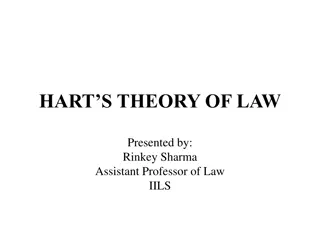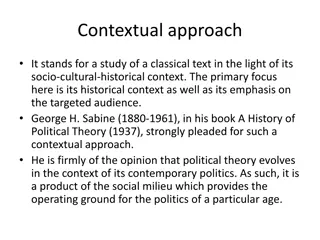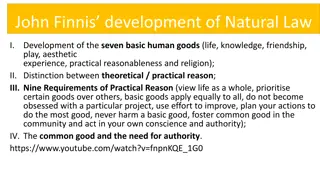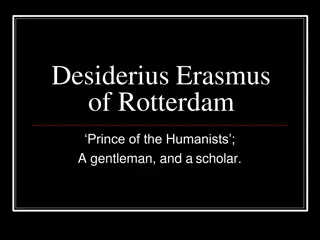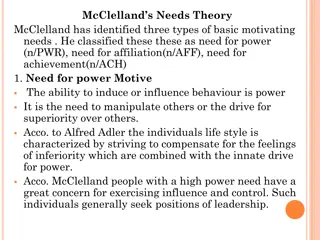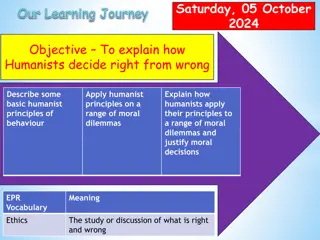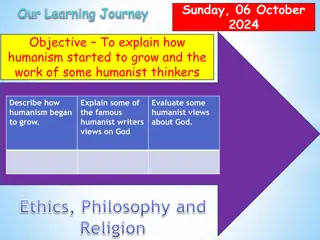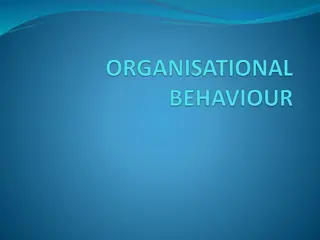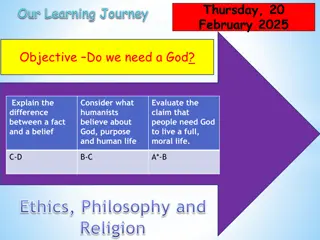Basic Needs Theory & Humanist Perspective of Development
Introducing the Basic Needs Theory, focusing on eradicating poverty through development strategies. Explore humanist perspectives in development studies, major arguments, features, and more. Reading recommendations included.
Download Presentation

Please find below an Image/Link to download the presentation.
The content on the website is provided AS IS for your information and personal use only. It may not be sold, licensed, or shared on other websites without obtaining consent from the author.If you encounter any issues during the download, it is possible that the publisher has removed the file from their server.
You are allowed to download the files provided on this website for personal or commercial use, subject to the condition that they are used lawfully. All files are the property of their respective owners.
The content on the website is provided AS IS for your information and personal use only. It may not be sold, licensed, or shared on other websites without obtaining consent from the author.
E N D
Presentation Transcript
THEORIES OF DEVELOPMENT: BASIC NEEDS THEORY AND A HUMANIST PERSPECTIVE OF DEVELOPMENT Lecturer: Dr. Maame Adwoa A. Gyekye-Jandoh Contact Information: mgyekyej@yahoo.com College of Education School of Continuing and Distance Education 2014/2015 2016/2017
Session Overview Overview This session introduces a theory that seeks to bring the reduction and even abolition of poverty to the forefront of debates about development or the lack thereof. The main idea of the Basic Needs Theory is that development is only achieved and complete if there is a development strategy aimed at abolishing absolute poverty within a short period of time. The elements of such a strategy will also be discussed. It also examines the way in which more humane theories of development seem to have become increasingly dominant in the field of development studies. Slide 2
Session Outline The key topics to be covered in this session are as follows: Topic One: Major Arguments of the Basic Needs Theory Topic Two: Seven Features of a Basic Needs Strategy Topic Three: Towards a Humanist Perspective of Development Slide 3
Reading List Paul Streeten and Shahid Burki (1978). Basic Needs: Some Issues . Slide 4
Topic One MAJOR ARGUMENTS OF THE BASIC NEEDS THEORY Slide 5
Major Arguments of the Basic Needs Theory 1. The theory argues that in spite of high growth rates and improvement in social indicators such as in literacy and infant mortality, pessimism is still widespread, because aggregate economic growth has not helped the poorer half of the rapidly growing populations in developing nations much. Growth has been uneven and has not contributed much to the alleviation of the misery of poor people. Although growth has brought an emphasis on employment and redistribution of income and wealth, it has not gone far enough towards eradicating absolute poverty. 2. The theory argues that the structure of ownership and power, and the policies pursued by governments prevent the poor from benefiting from growth. Therefore solutions to the problem of poverty should include helping the poor by raising their productivity through raising demand for their goods and services, and by improving their skills. Slide 6
Major Arguments of the Basic Needs Theory 3. It asserts that the economic emphasis in development studies overlooked the purpose of development policies, which is not only to eradicate physical poverty but to provide all humans with the opportunities to develop their full potential (Streeten and Burki 1981). Definition and Aim of Basic Needs Basic needs is concerned with the purpose of development, which is to raise the sustainable level of living of the poor masses as rapidly as is feasible and to provide all human beings with the opportunity to develop their full potential. The aim of a basic needs strategy (BSN) is to increase and redistribute production so as to eradicate deprivation that arises from a lack of basic goods and services. Slide 7
Defining a Package of Basic Needs Defining a Package of Basic Needs Advocates of the basic needs theory insist that a package of basic needs must be defined generally, although societies can define their own basket of basic needs (goods and services). The theory argues that there is a hierarchy of basics needs: Bare survival basic needs; Continued survival basic needs; Productive survival basic needs; and Non-material basic needs. It also argues that a continued survival package is more modest than a package of basic needs for productive survival. Slide 8
Defining a Package of Basic Needs Defining a package of basic needs is useful because it can help governments identify the most important needs people have and try to provide them. This would make talk about development more real to people from the poorer nations. A Basic Needs Strategy (BNS) must therefore be followed. Slide 9
Sample Questions Explain the purpose of a basic needs theory. Discuss briefly the need for governments to define a package of basic needs. Slide 10
Topic Two SEVEN FEATURES OF A BASIC NEEDS STRATEGY Slide 11
Seven Features of a Basic Needs Strategy Basic needs advocates suggest that a basic needs strategy (BNS) is needed in order to be able to achieve the aim of the theory increase and redistribute production with a view to eradicating poverty. There are seven features of this BNS. 1. A BNS gives high priority to meeting the specific needs of the poorest people, not raising productivity alone. 2. It stresses the importance of efforts to redress absolute deprivation. Such efforts have worked in China, and are very relevant to countries with a high concentration of absolute poverty. Slide 12
Seven Features of a Basic Needs Strategy 3. A BNS emphasizes supply management, that is, increases in the incomes of the poor should not be neutralized by increases in prices of goods and services. 4. There is a substantial role for the government due to BNS s emphasis on restructuring production. Government is also needed to provide education, health, water supply and sanitation, which are important public services. 5. A basic needs strategy sometimes defines basic needs in terms of the characteristics of goods and services, for example, the calories that people need to grow and live well rather than the type of food (rice or maize) per se. Slide 13
Seven Features of a Basic Needs Strategy continued 6. A BNS implies setting some limits to the unrestricted exercise of consumers demand in the market. This means that it discourages just mere consumerism or materialistic culture. 7. Basic needs are defined broadly as both material and non-material needs, therefore a BNS stresses motivational, institutional, and organizational change (Streeten and Burki 1981). Everyone involved, the government and the people, must have a drive to bring the desired change in organizations and in the institutions (finance ministries, social and development agencies, government and public institutions) that will have the biggest responsibility to make sure basic needs of shelter, food, etc. get to the poorest people. Slide 14
Conclusion to Topic Two To conclude, it is important to remember that basic needs theory stresses the need for a major restructuring in political and economic power relationships in a society, which is necessary for a genuine pursuit of a basic needs strategy (BNS). A global Basic Needs Program would rely heavily on transfers (aid) from rich nations. Countries that have given high priority to basic needs include Sri Lanka, Burma, Tanzania, Angola, Mozambique, and Vietnam. Slide 15
Additional Questions Do you agree that a global basic needs programme would need transfers of aid from the advanced rich countries to the poorer developing countries? Why or why not? Briefly explain what bare survival, continued survival, productive survival, and non-material basic needs mean under basic needs theory. Slide 16
Topic Three TOWARDS A HUMANIST PERSPECTIVE OF DEVELOPMENT Slide 17
Towards a Humanist Perspective of Development It is hoped that by now you are familiar with all the theories of development modernization theory, dependency theory, basic needs theory, and the humanist perspective of development discussed. If you have done your reading and activities carefully, you will have noticed that the first two theories have focused a lot on industrialization and how to develop the cultures, structures and economies of the less developed countries. The last two perspectives basic needs and the humanist however move in a broader direction with more of an emphasis on the development of the individual and his or her well-being as an essential part, if not means, of developing an entire nation. These last two perspectives, therefore, pave the way for more humane theories and conceptions (meanings) of development in the field of development studies. Slide 18
Towards a Humanist Perspective of Development The fact that since the 1980s, we have had analyses of development or the lack of it situated in the context of the well- being, potential, and enrichment of the individual signals a shift in development thinking from a narrow conception of development to a broader conception of development which places the individual human being at the center of the development agenda. This broader conception of development acknowledges the importance of economic growth through industrialization or even agricultural development, but goes further in highlighting the poverty and misery still characterizing majority of the populations of less developed countries of the world, and the fact that if this poverty and deprivation is not done away with, development cannot be said to have taken place. Slide 19
Towards More Humane Theories in Development Studies Therefore, there seems to be a trend in Development Studies toward more humane ideas and theories of development. This is even borne out in real life by the changing policies of international development agencies such as the World Bank and IMF that now emphasize poverty reduction, and not just fiscal responsibility and prudence, in the quest for economic development. The UN Millennium Development Goals, adopted in 2000, and the UN Sustainable Development Goals adopted in December 2015, also focus on poverty alleviation and the empowerment of individuals (especially women and children) through education and health. Is this trend good or bad for the future of Development Studies, and development in general? Slide 20
Towards More Humane Theories in Development Studies Considering the fact that more than a third of the world s population today lives in abject poverty despite hundreds of development projects, programs, and efforts, it is a good thing for Development Studies to recognize that at the end of the day, one cannot talk about development in a country if a quarter or more of its population is miserable and very poor. Scholars of the humanist perspective of development put it correctly: empowering the individual so that he or she can have the capacity to improve their circumstances, the freedom, and self-esteem to want and pursue better lives for themselves and their families, would in the long-run bring development in terms of economic growth, reduce poverty, and sustain the improvements and advances in the lives of people and their nations. Slide 21
Conclusion to Topic Three Development Studies, it seems, would be better off if it continued to develop more analyses and practical policies that are in tune with broader, more humane theories and conceptions of development. Slide 22
Conclusion of Session 4 In this session, you have learned about the basic needs theory and its major arguments. You have become familiar with defining a package of basic needs, and you have learned that it is very important to eradicate absolute poverty under this theory in order for any development to be said to have taken place. Finally, you have also been introduced to the seven main features of a basic needs strategy, most importantly the fact that governments of developing countries have a big role to play in providing important public services like health, education, and sanitation to the poor. You have also become familiar with what is increasingly becoming dominant in development studies: a humane/humanist theory or more humane theories of development. Slide 23
References Streeten, Paul and Shahid Burki. Basic Needs: Some Issues. World Development. p. 411-420. Todaro, Michael. 2000. Economic Development. England: Pearson Education Limited. http://www.un.org/millennium goals/ http://digitalmedia.worldbank.org/projectsandops/strategy .htm Slide 24
